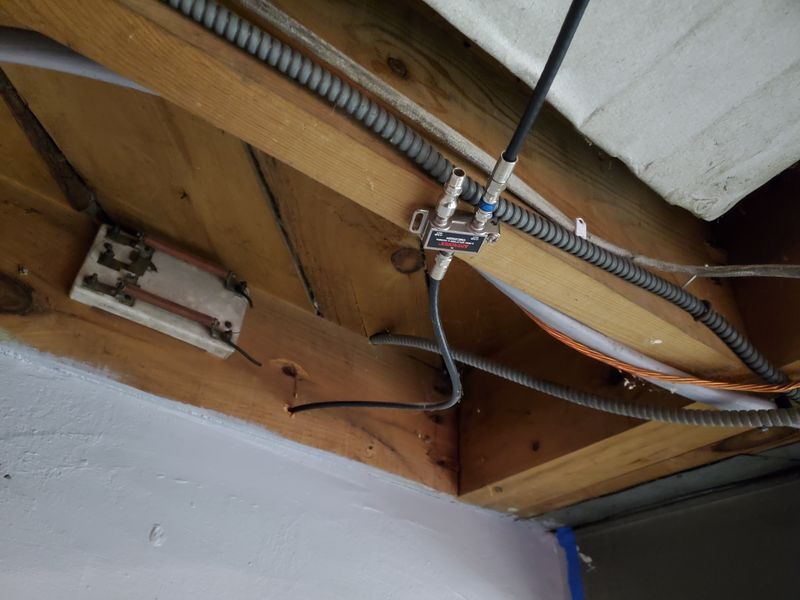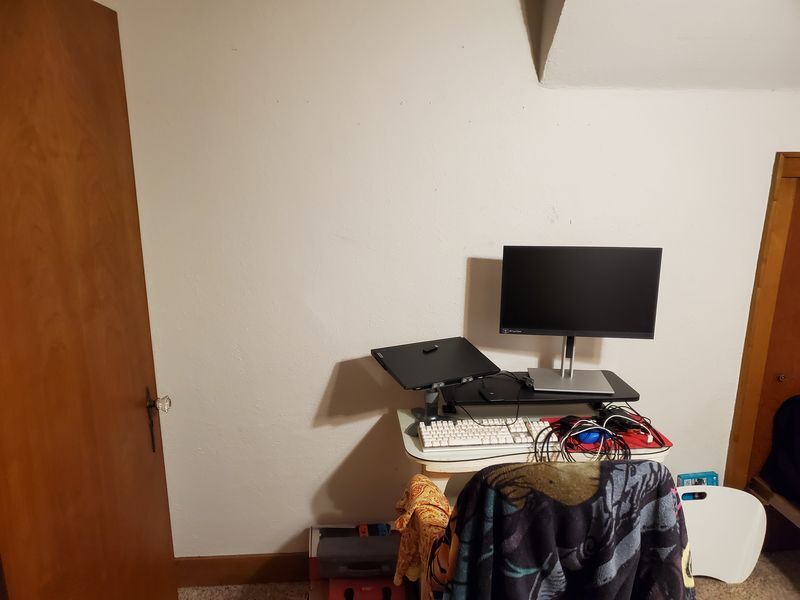Networking House
Video updates for this article:
- Installing the Network Cabinet in the Basement
- Running Ethernet to Living Room WAP
- Running Wiring to a Garage
I’ve been absent from uploading my selfhosting videos, but I’ve recently moved into a new (to me) house and will have a bunch of new content coming out after I get settled into it. This house is going to be setup the way I’ve always wanted, and in this article I’m going to go over everything and what you can expect in some upcoming videos.
Right now this is how my equipment is laid out under my TV stand in the living room. You can see the router, cable modem, Thinkcentre with a 2TB external, Rockpro64 in a NAS case with a 8TB internal, and a USB hard drive enclosure with more internal hard drives connected to it.
Honestly, this works, the WiFi covers the house, and the servers run fine here, but I want it the way I want it. So all this equipment will be moving to a small wall-mounted network cabinet downstairs. I’m going to place it next to the breaker panel where the internet feed comes into the basement. Although I’m putting in a network cabinet I don’t want power hungry enterprise equipment that sounds like a jet engine taking off, I like the quiet and power efficient hardware that I’m running; I’m going for a happy medium here. A balance between efficiency, cost, and loads.
In that network cabinet I’m going to have a rack mounted power strip, 8 port gigabit switch with 4 POE ports, and patch panel to keep the lines organized and tidy. My Thinkcentre, Rockpro64, and USB enclosure will also be inside. And I will likely also be getting another Thinkcentre, because selfhosting is addicting, and I want to run more and more services. I will have a couple IP cameras and will be selfhosting the management software for them, and I anticipate that will use a fair amount of system resources.
So I’ll make a short video on setting this up, but in reality this isn’t going to be too informative, I’m basically moving my equipment into a different area and putting it into a box. But what I believe will be informative content is that I’m going to be running a bunch of ethernet to this area and into the patch panel in the rack. I’ve spent the better part of the last decade running wire, I have a lot of experience fishing wires in walls and cutting in outlets so I want to make a couple of videos explaining the process. I’m going to try to impart as much of that experience as I can in these videos, what I am looking out for as I’m doing it, tricks I’ve learned, tools I like to use, etc. That way if you want to run some line in your home, you can do it with better confidence and understanding.
Right now this is how the lines are ran. If we take a look behind my TV we can see 3 really nice big holes drilled into the flooring.
That is where the cable line is coming up to provide signal to the modem, and where an antenna line is coming up to provide OTA signal to the TV. Drilling holes in the floor is amateur. I’m going to fix this by finding similar wood, using a hole saw to cut out a rough diameter of the wood, sanding it down to the proper size, gluing it and plugging these holes. Then I will put in a cable outlet in the wall behind the TV for the antenna since I get 38 channels from it and it’s a good backup to my IPTV service.
But the bulk of the videos will be about running ethernet wiring. So there are 4 different areas that I want to run ethernet and each one is slightly different on ease and obstacles which is great for me to be able to provide varying examples.
The first spot will be in the living room where I’m going to have a WAP. It is going to go next to the thermostat.
So you can see there are two thermostats, and the one on the left is no longer in use. They put in a new one and never removed the old one. I want to remove it as it’s no longer in use and this WAP will look good there (run on POE) and cover the hole, meaning I don’t have to spend time patching it. Not only that, but there may still be an old wire behind it that I can use to pull up the ethernet wire, so this will be a very easy run.
I have a detached garage with metal siding. The WiFi signal barely reaches out to it, and the metal siding kills it. So I am going to bury an ethernet out to the garage and put another WAP out there. There will also be an IP camera ran off the WAP with ethernet overlooking the garage. As the WAP has a POE output port, I will only need to run one ethernet for both the WAP and IP camera, but I will run two for redundancy and expansion. This is also an easy run, it just takes a little digging.
There will also be an outdoor IP camera basically overlooking this view of the backyard and the garage running on POE. This run will need to be house-wrapped and made to be hidden. There are many ways to hide it, J-channel, behind the siding, etc. This run will be a bit different than the others.
The office is on the second floor. And both my desk and my wife’s desk are up there on different walls. My desk is on the exterior wall so it will be a little easier to run from the basement up to it. But my wife’s desk is on an interior wall that doesn’t extend down to the basement, so I will need to run that line up with my line, but then continue it into the attic, across the ceiling, and down into her interior wall.
So these videos will be coming out after I get settled in and the weather is warmer. I’m still moving in and setting up my garage and then I will be back to creating more content for the channel. Stay tuned.









